Social Media Addiction's Impact on Mental Health: A Study on LSST
VerifiedAdded on 2023/06/11
|36
|6481
|312
Report
AI Summary
This report investigates the causes and effects of social media addiction on the mental health of students in LSST, London, utilizing a quantitative research approach. The study reveals a high level of social media addiction among LSST students, with many checking social media frequently and considering themselves addicted. The research, employing SPSS for data analysis, found no significant difference in views between males and females regarding the negative effects of social media. It highlights that students spend considerable time on social media, impacting their sleep, behavior, and academic performance. The study concludes that reducing social media addiction among teenagers is crucial for improving their overall mental health and academic outcomes.
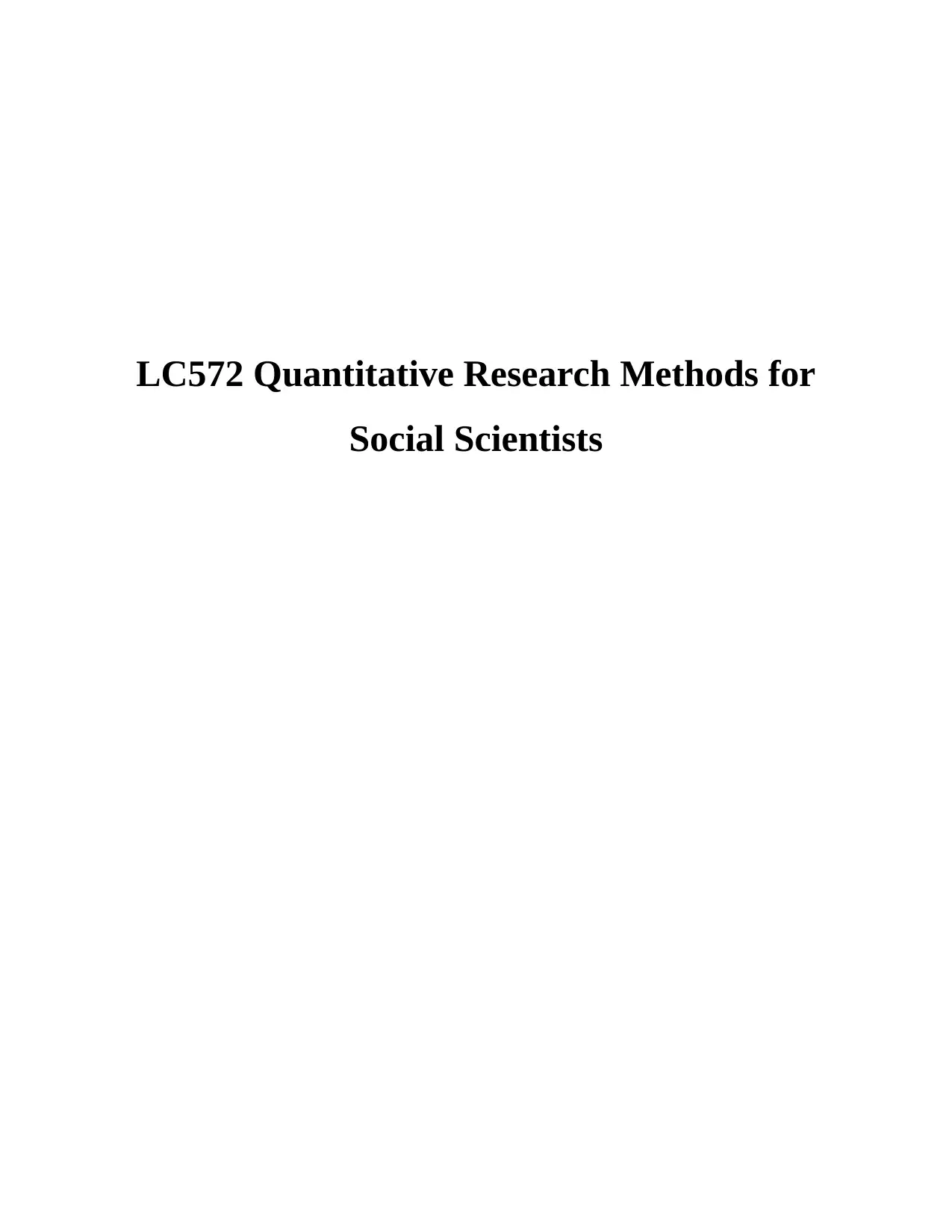
LC572 Quantitative Research Methods for
Social Scientists
Social Scientists
Paraphrase This Document
Need a fresh take? Get an instant paraphrase of this document with our AI Paraphraser
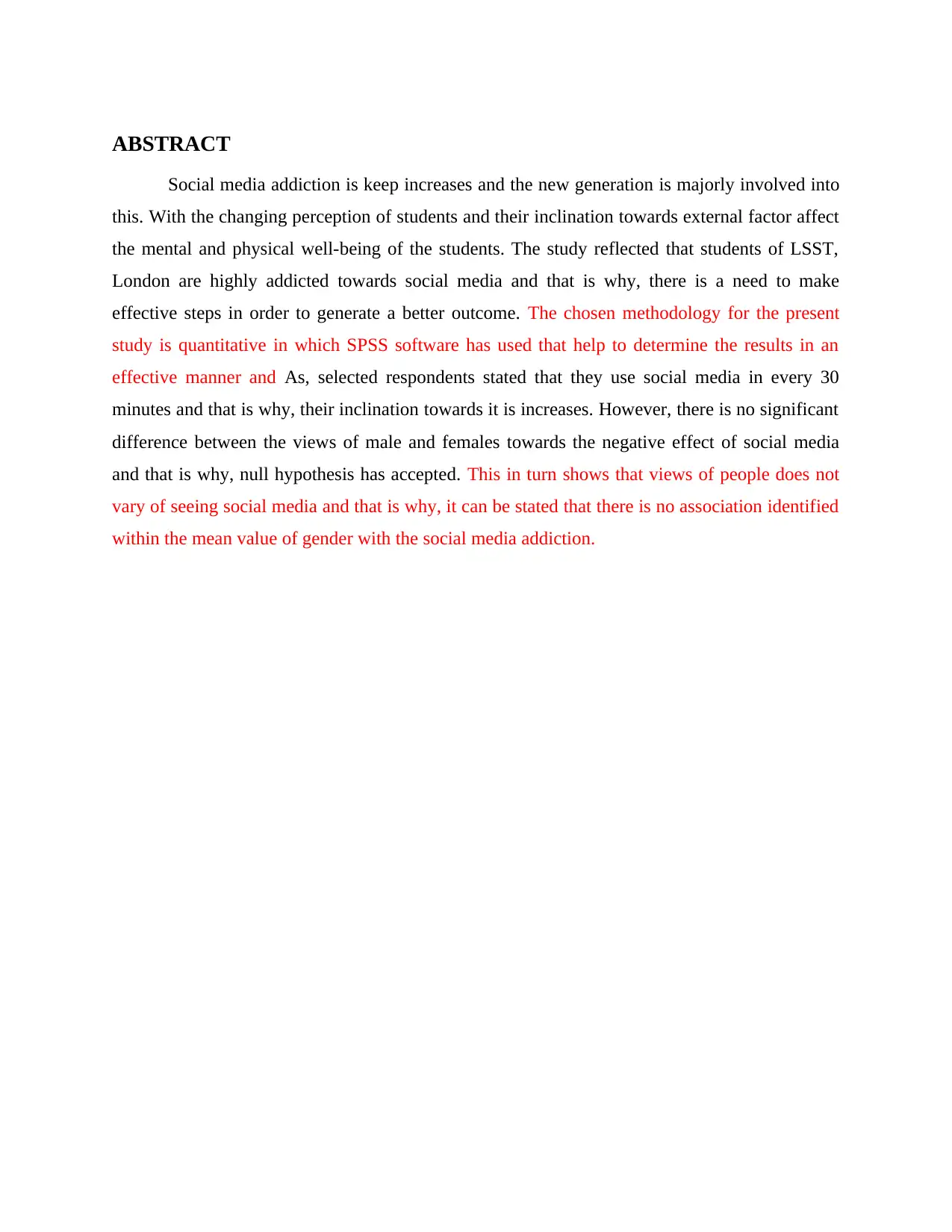
ABSTRACT
Social media addiction is keep increases and the new generation is majorly involved into
this. With the changing perception of students and their inclination towards external factor affect
the mental and physical well-being of the students. The study reflected that students of LSST,
London are highly addicted towards social media and that is why, there is a need to make
effective steps in order to generate a better outcome. The chosen methodology for the present
study is quantitative in which SPSS software has used that help to determine the results in an
effective manner and As, selected respondents stated that they use social media in every 30
minutes and that is why, their inclination towards it is increases. However, there is no significant
difference between the views of male and females towards the negative effect of social media
and that is why, null hypothesis has accepted. This in turn shows that views of people does not
vary of seeing social media and that is why, it can be stated that there is no association identified
within the mean value of gender with the social media addiction.
Social media addiction is keep increases and the new generation is majorly involved into
this. With the changing perception of students and their inclination towards external factor affect
the mental and physical well-being of the students. The study reflected that students of LSST,
London are highly addicted towards social media and that is why, there is a need to make
effective steps in order to generate a better outcome. The chosen methodology for the present
study is quantitative in which SPSS software has used that help to determine the results in an
effective manner and As, selected respondents stated that they use social media in every 30
minutes and that is why, their inclination towards it is increases. However, there is no significant
difference between the views of male and females towards the negative effect of social media
and that is why, null hypothesis has accepted. This in turn shows that views of people does not
vary of seeing social media and that is why, it can be stated that there is no association identified
within the mean value of gender with the social media addiction.
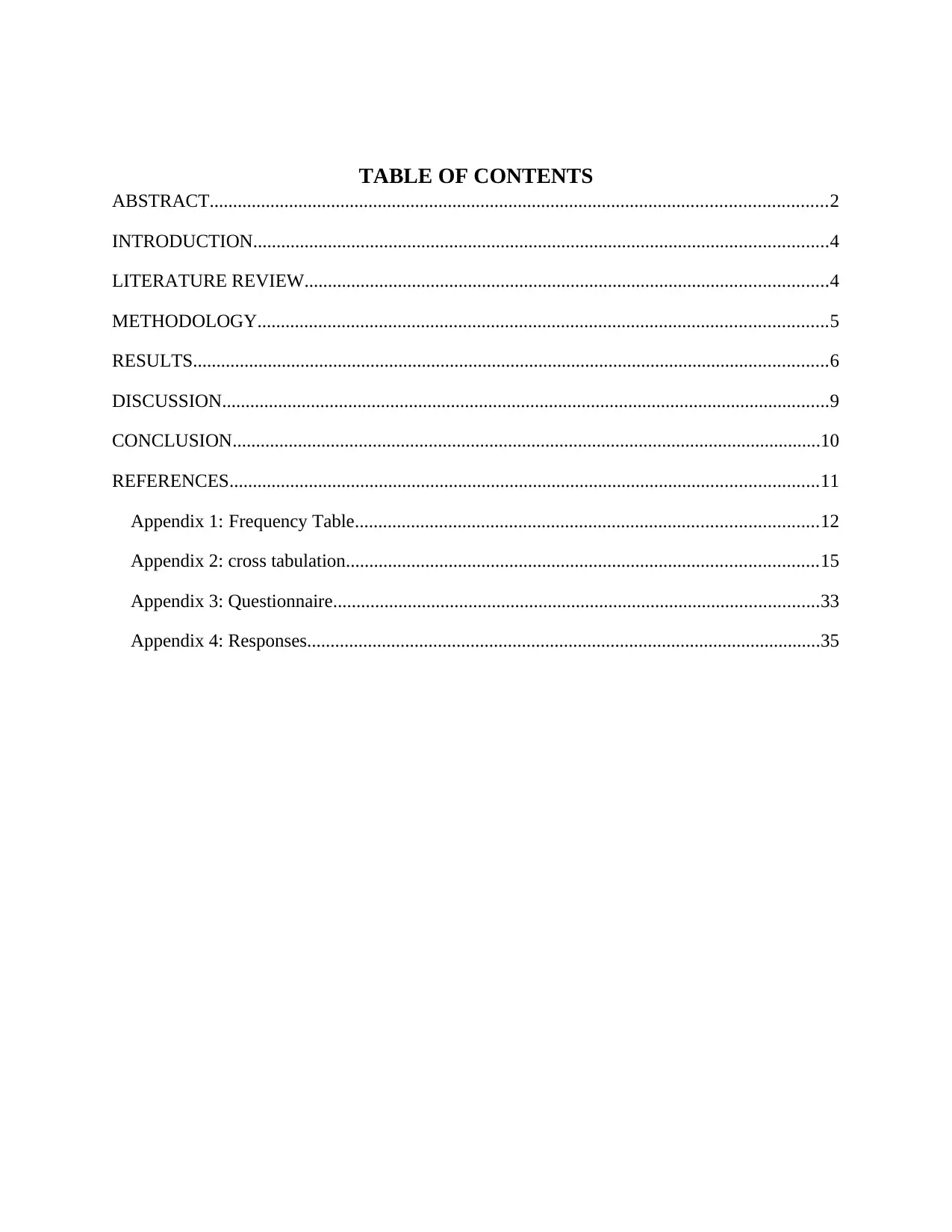
TABLE OF CONTENTS
ABSTRACT....................................................................................................................................2
INTRODUCTION...........................................................................................................................4
LITERATURE REVIEW................................................................................................................4
METHODOLOGY..........................................................................................................................5
RESULTS........................................................................................................................................6
DISCUSSION..................................................................................................................................9
CONCLUSION..............................................................................................................................10
REFERENCES..............................................................................................................................11
Appendix 1: Frequency Table...................................................................................................12
Appendix 2: cross tabulation.....................................................................................................15
Appendix 3: Questionnaire........................................................................................................33
Appendix 4: Responses..............................................................................................................35
ABSTRACT....................................................................................................................................2
INTRODUCTION...........................................................................................................................4
LITERATURE REVIEW................................................................................................................4
METHODOLOGY..........................................................................................................................5
RESULTS........................................................................................................................................6
DISCUSSION..................................................................................................................................9
CONCLUSION..............................................................................................................................10
REFERENCES..............................................................................................................................11
Appendix 1: Frequency Table...................................................................................................12
Appendix 2: cross tabulation.....................................................................................................15
Appendix 3: Questionnaire........................................................................................................33
Appendix 4: Responses..............................................................................................................35
⊘ This is a preview!⊘
Do you want full access?
Subscribe today to unlock all pages.

Trusted by 1+ million students worldwide
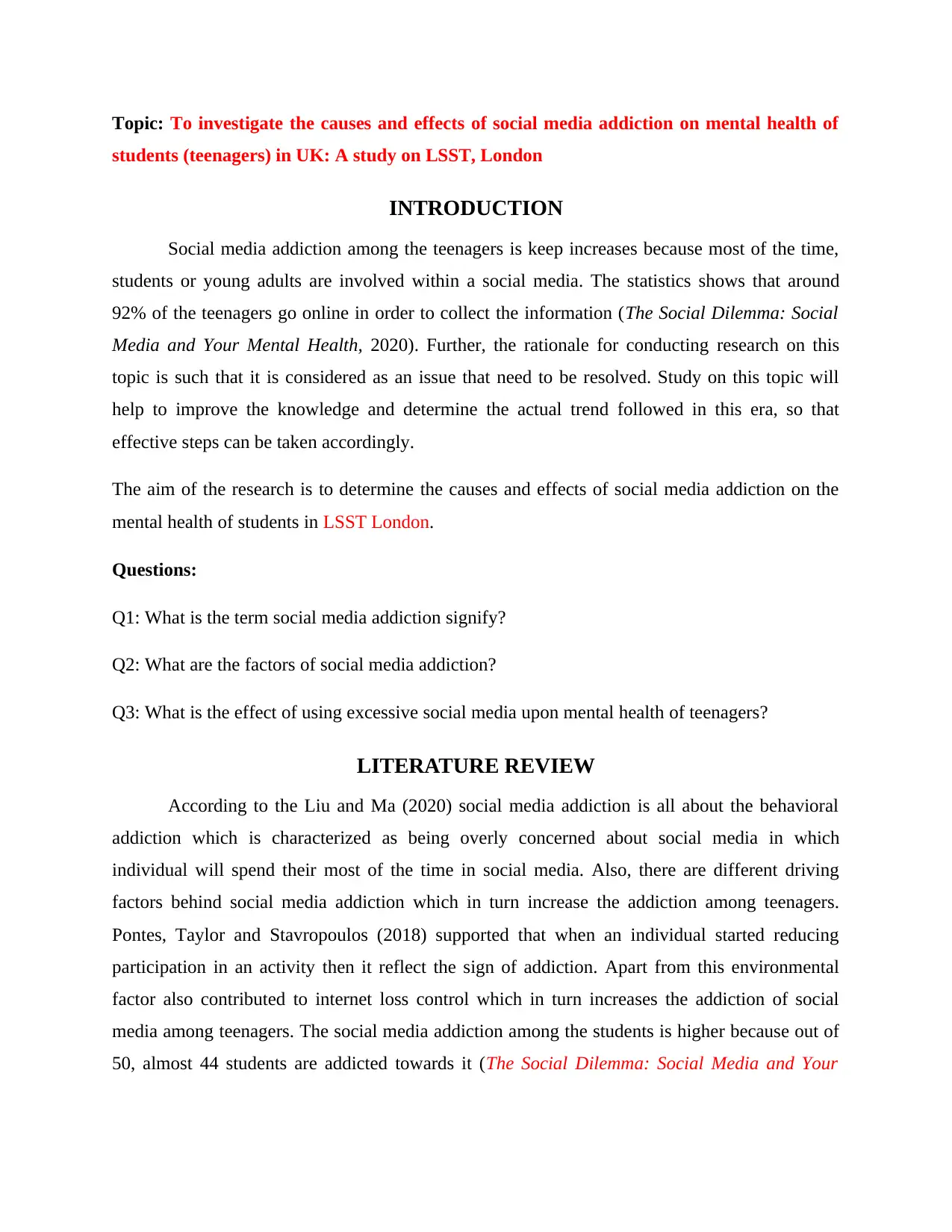
Topic: To investigate the causes and effects of social media addiction on mental health of
students (teenagers) in UK: A study on LSST, London
INTRODUCTION
Social media addiction among the teenagers is keep increases because most of the time,
students or young adults are involved within a social media. The statistics shows that around
92% of the teenagers go online in order to collect the information (The Social Dilemma: Social
Media and Your Mental Health, 2020). Further, the rationale for conducting research on this
topic is such that it is considered as an issue that need to be resolved. Study on this topic will
help to improve the knowledge and determine the actual trend followed in this era, so that
effective steps can be taken accordingly.
The aim of the research is to determine the causes and effects of social media addiction on the
mental health of students in LSST London.
Questions:
Q1: What is the term social media addiction signify?
Q2: What are the factors of social media addiction?
Q3: What is the effect of using excessive social media upon mental health of teenagers?
LITERATURE REVIEW
According to the Liu and Ma (2020) social media addiction is all about the behavioral
addiction which is characterized as being overly concerned about social media in which
individual will spend their most of the time in social media. Also, there are different driving
factors behind social media addiction which in turn increase the addiction among teenagers.
Pontes, Taylor and Stavropoulos (2018) supported that when an individual started reducing
participation in an activity then it reflect the sign of addiction. Apart from this environmental
factor also contributed to internet loss control which in turn increases the addiction of social
media among teenagers. The social media addiction among the students is higher because out of
50, almost 44 students are addicted towards it (The Social Dilemma: Social Media and Your
students (teenagers) in UK: A study on LSST, London
INTRODUCTION
Social media addiction among the teenagers is keep increases because most of the time,
students or young adults are involved within a social media. The statistics shows that around
92% of the teenagers go online in order to collect the information (The Social Dilemma: Social
Media and Your Mental Health, 2020). Further, the rationale for conducting research on this
topic is such that it is considered as an issue that need to be resolved. Study on this topic will
help to improve the knowledge and determine the actual trend followed in this era, so that
effective steps can be taken accordingly.
The aim of the research is to determine the causes and effects of social media addiction on the
mental health of students in LSST London.
Questions:
Q1: What is the term social media addiction signify?
Q2: What are the factors of social media addiction?
Q3: What is the effect of using excessive social media upon mental health of teenagers?
LITERATURE REVIEW
According to the Liu and Ma (2020) social media addiction is all about the behavioral
addiction which is characterized as being overly concerned about social media in which
individual will spend their most of the time in social media. Also, there are different driving
factors behind social media addiction which in turn increase the addiction among teenagers.
Pontes, Taylor and Stavropoulos (2018) supported that when an individual started reducing
participation in an activity then it reflect the sign of addiction. Apart from this environmental
factor also contributed to internet loss control which in turn increases the addiction of social
media among teenagers. The social media addiction among the students is higher because out of
50, almost 44 students are addicted towards it (The Social Dilemma: Social Media and Your
Paraphrase This Document
Need a fresh take? Get an instant paraphrase of this document with our AI Paraphraser
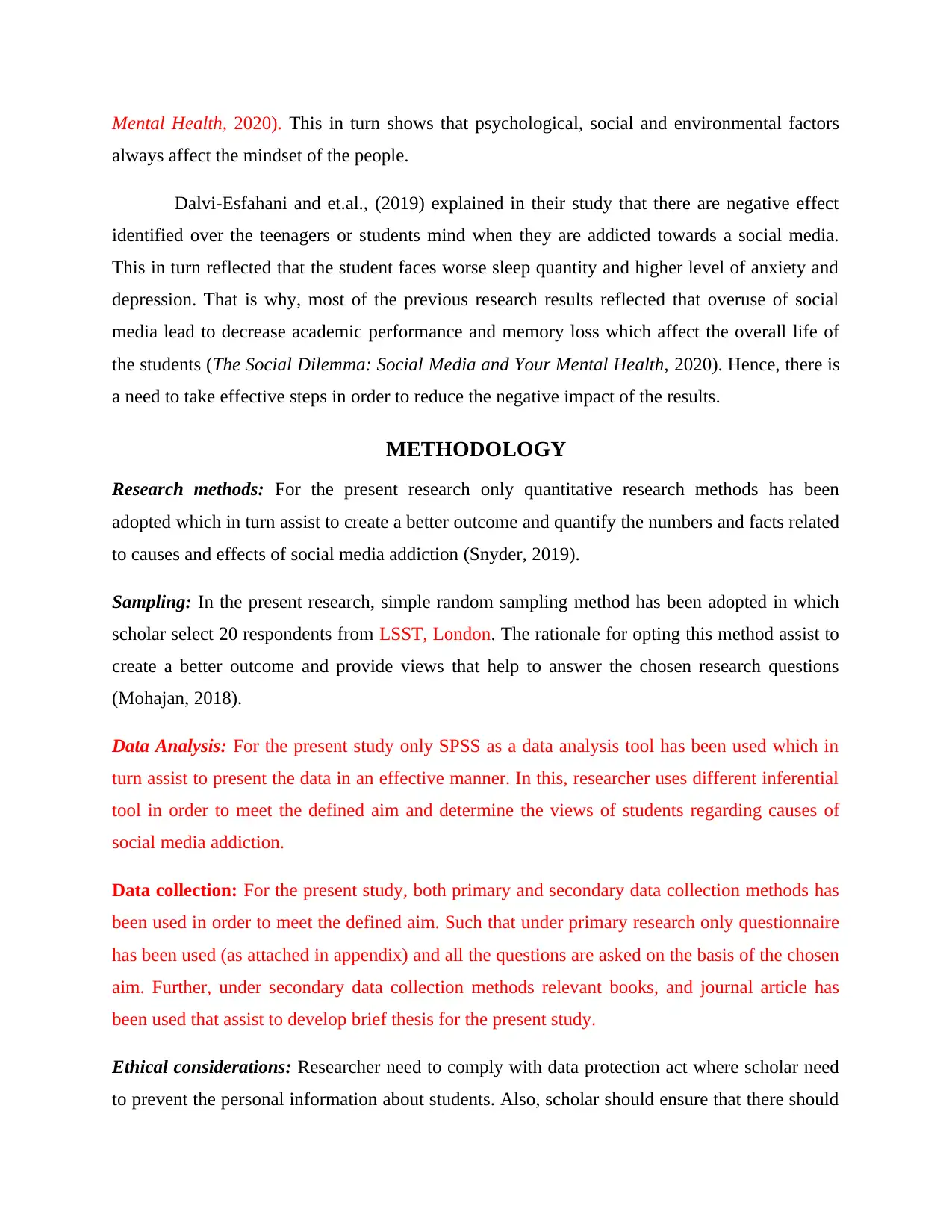
Mental Health, 2020). This in turn shows that psychological, social and environmental factors
always affect the mindset of the people.
Dalvi-Esfahani and et.al., (2019) explained in their study that there are negative effect
identified over the teenagers or students mind when they are addicted towards a social media.
This in turn reflected that the student faces worse sleep quantity and higher level of anxiety and
depression. That is why, most of the previous research results reflected that overuse of social
media lead to decrease academic performance and memory loss which affect the overall life of
the students (The Social Dilemma: Social Media and Your Mental Health, 2020). Hence, there is
a need to take effective steps in order to reduce the negative impact of the results.
METHODOLOGY
Research methods: For the present research only quantitative research methods has been
adopted which in turn assist to create a better outcome and quantify the numbers and facts related
to causes and effects of social media addiction (Snyder, 2019).
Sampling: In the present research, simple random sampling method has been adopted in which
scholar select 20 respondents from LSST, London. The rationale for opting this method assist to
create a better outcome and provide views that help to answer the chosen research questions
(Mohajan, 2018).
Data Analysis: For the present study only SPSS as a data analysis tool has been used which in
turn assist to present the data in an effective manner. In this, researcher uses different inferential
tool in order to meet the defined aim and determine the views of students regarding causes of
social media addiction.
Data collection: For the present study, both primary and secondary data collection methods has
been used in order to meet the defined aim. Such that under primary research only questionnaire
has been used (as attached in appendix) and all the questions are asked on the basis of the chosen
aim. Further, under secondary data collection methods relevant books, and journal article has
been used that assist to develop brief thesis for the present study.
Ethical considerations: Researcher need to comply with data protection act where scholar need
to prevent the personal information about students. Also, scholar should ensure that there should
always affect the mindset of the people.
Dalvi-Esfahani and et.al., (2019) explained in their study that there are negative effect
identified over the teenagers or students mind when they are addicted towards a social media.
This in turn reflected that the student faces worse sleep quantity and higher level of anxiety and
depression. That is why, most of the previous research results reflected that overuse of social
media lead to decrease academic performance and memory loss which affect the overall life of
the students (The Social Dilemma: Social Media and Your Mental Health, 2020). Hence, there is
a need to take effective steps in order to reduce the negative impact of the results.
METHODOLOGY
Research methods: For the present research only quantitative research methods has been
adopted which in turn assist to create a better outcome and quantify the numbers and facts related
to causes and effects of social media addiction (Snyder, 2019).
Sampling: In the present research, simple random sampling method has been adopted in which
scholar select 20 respondents from LSST, London. The rationale for opting this method assist to
create a better outcome and provide views that help to answer the chosen research questions
(Mohajan, 2018).
Data Analysis: For the present study only SPSS as a data analysis tool has been used which in
turn assist to present the data in an effective manner. In this, researcher uses different inferential
tool in order to meet the defined aim and determine the views of students regarding causes of
social media addiction.
Data collection: For the present study, both primary and secondary data collection methods has
been used in order to meet the defined aim. Such that under primary research only questionnaire
has been used (as attached in appendix) and all the questions are asked on the basis of the chosen
aim. Further, under secondary data collection methods relevant books, and journal article has
been used that assist to develop brief thesis for the present study.
Ethical considerations: Researcher need to comply with data protection act where scholar need
to prevent the personal information about students. Also, scholar should ensure that there should
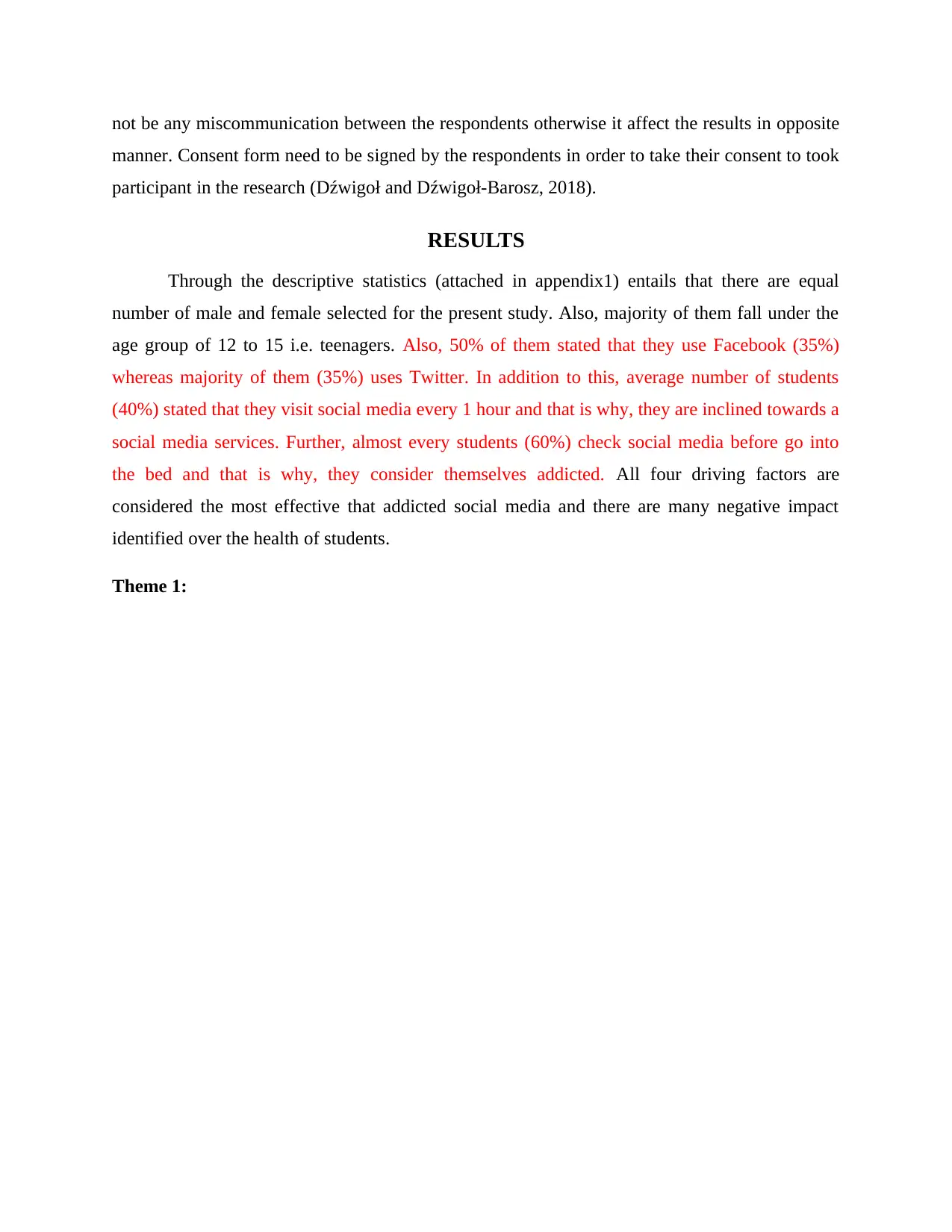
not be any miscommunication between the respondents otherwise it affect the results in opposite
manner. Consent form need to be signed by the respondents in order to take their consent to took
participant in the research (Dźwigoł and Dźwigoł-Barosz, 2018).
RESULTS
Through the descriptive statistics (attached in appendix1) entails that there are equal
number of male and female selected for the present study. Also, majority of them fall under the
age group of 12 to 15 i.e. teenagers. Also, 50% of them stated that they use Facebook (35%)
whereas majority of them (35%) uses Twitter. In addition to this, average number of students
(40%) stated that they visit social media every 1 hour and that is why, they are inclined towards a
social media services. Further, almost every students (60%) check social media before go into
the bed and that is why, they consider themselves addicted. All four driving factors are
considered the most effective that addicted social media and there are many negative impact
identified over the health of students.
Theme 1:
manner. Consent form need to be signed by the respondents in order to take their consent to took
participant in the research (Dźwigoł and Dźwigoł-Barosz, 2018).
RESULTS
Through the descriptive statistics (attached in appendix1) entails that there are equal
number of male and female selected for the present study. Also, majority of them fall under the
age group of 12 to 15 i.e. teenagers. Also, 50% of them stated that they use Facebook (35%)
whereas majority of them (35%) uses Twitter. In addition to this, average number of students
(40%) stated that they visit social media every 1 hour and that is why, they are inclined towards a
social media services. Further, almost every students (60%) check social media before go into
the bed and that is why, they consider themselves addicted. All four driving factors are
considered the most effective that addicted social media and there are many negative impact
identified over the health of students.
Theme 1:
⊘ This is a preview!⊘
Do you want full access?
Subscribe today to unlock all pages.

Trusted by 1+ million students worldwide
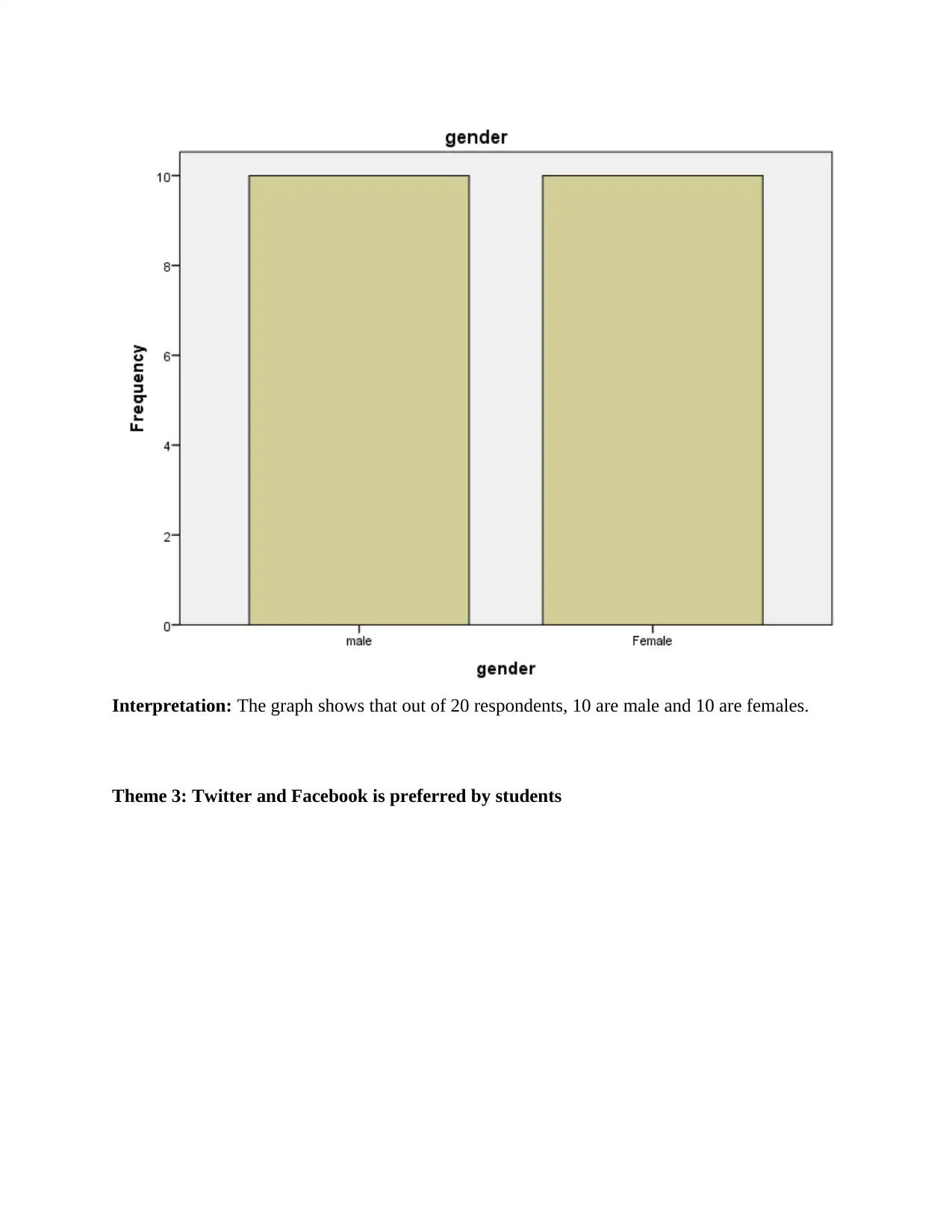
Interpretation: The graph shows that out of 20 respondents, 10 are male and 10 are females.
Theme 3: Twitter and Facebook is preferred by students
Theme 3: Twitter and Facebook is preferred by students
Paraphrase This Document
Need a fresh take? Get an instant paraphrase of this document with our AI Paraphraser
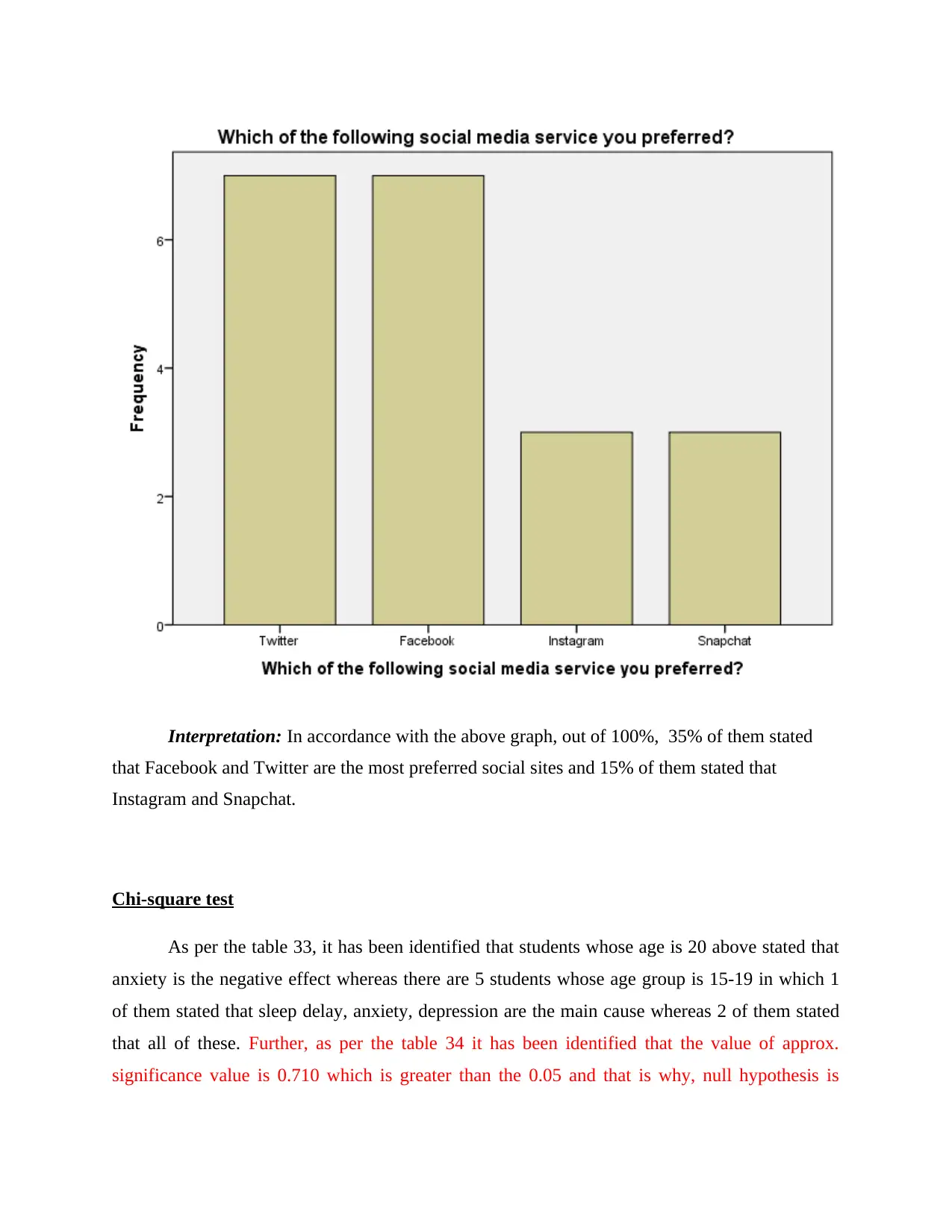
Interpretation: In accordance with the above graph, out of 100%, 35% of them stated
that Facebook and Twitter are the most preferred social sites and 15% of them stated that
Instagram and Snapchat.
Chi-square test
As per the table 33, it has been identified that students whose age is 20 above stated that
anxiety is the negative effect whereas there are 5 students whose age group is 15-19 in which 1
of them stated that sleep delay, anxiety, depression are the main cause whereas 2 of them stated
that all of these. Further, as per the table 34 it has been identified that the value of approx.
significance value is 0.710 which is greater than the 0.05 and that is why, null hypothesis is
that Facebook and Twitter are the most preferred social sites and 15% of them stated that
Instagram and Snapchat.
Chi-square test
As per the table 33, it has been identified that students whose age is 20 above stated that
anxiety is the negative effect whereas there are 5 students whose age group is 15-19 in which 1
of them stated that sleep delay, anxiety, depression are the main cause whereas 2 of them stated
that all of these. Further, as per the table 34 it has been identified that the value of approx.
significance value is 0.710 which is greater than the 0.05 and that is why, null hypothesis is
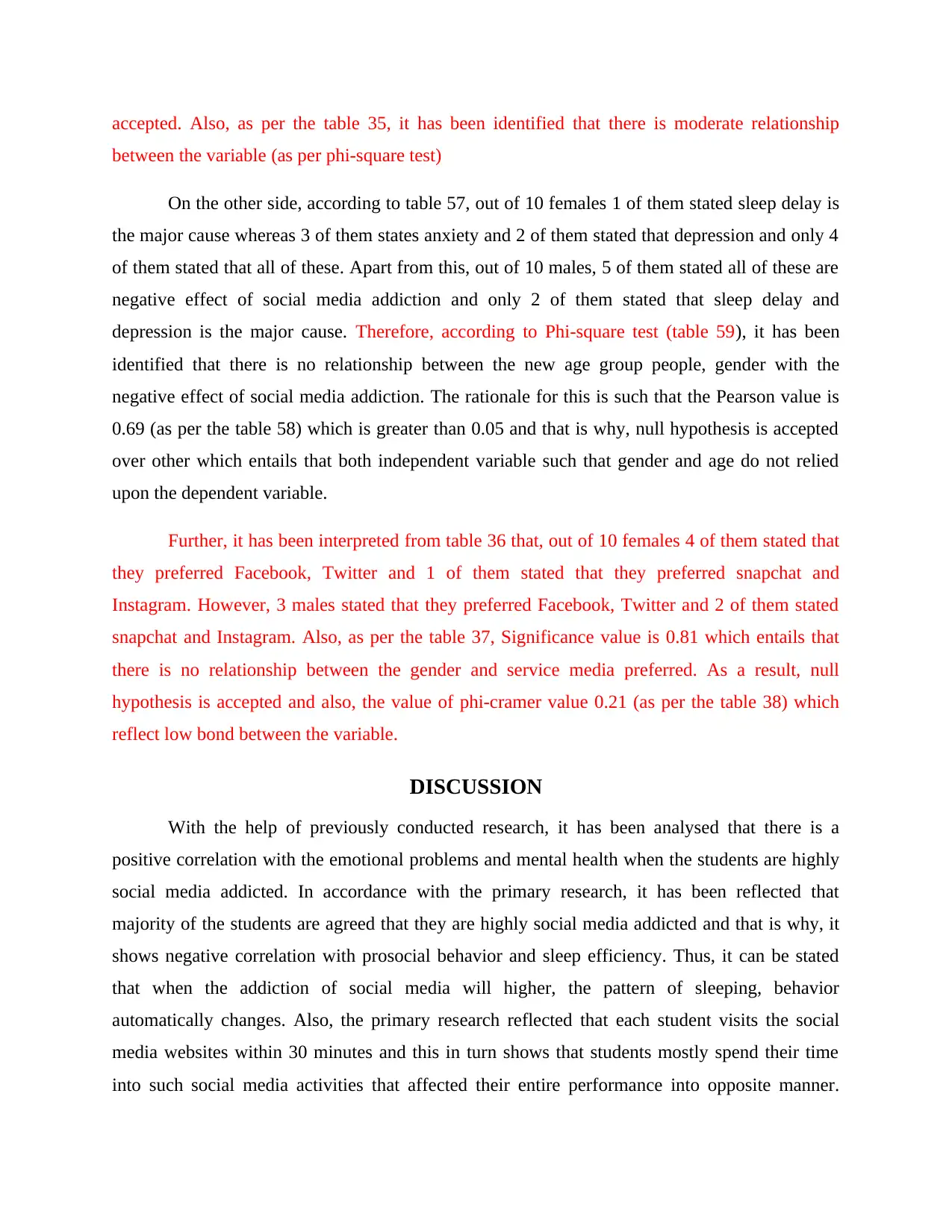
accepted. Also, as per the table 35, it has been identified that there is moderate relationship
between the variable (as per phi-square test)
On the other side, according to table 57, out of 10 females 1 of them stated sleep delay is
the major cause whereas 3 of them states anxiety and 2 of them stated that depression and only 4
of them stated that all of these. Apart from this, out of 10 males, 5 of them stated all of these are
negative effect of social media addiction and only 2 of them stated that sleep delay and
depression is the major cause. Therefore, according to Phi-square test (table 59), it has been
identified that there is no relationship between the new age group people, gender with the
negative effect of social media addiction. The rationale for this is such that the Pearson value is
0.69 (as per the table 58) which is greater than 0.05 and that is why, null hypothesis is accepted
over other which entails that both independent variable such that gender and age do not relied
upon the dependent variable.
Further, it has been interpreted from table 36 that, out of 10 females 4 of them stated that
they preferred Facebook, Twitter and 1 of them stated that they preferred snapchat and
Instagram. However, 3 males stated that they preferred Facebook, Twitter and 2 of them stated
snapchat and Instagram. Also, as per the table 37, Significance value is 0.81 which entails that
there is no relationship between the gender and service media preferred. As a result, null
hypothesis is accepted and also, the value of phi-cramer value 0.21 (as per the table 38) which
reflect low bond between the variable.
DISCUSSION
With the help of previously conducted research, it has been analysed that there is a
positive correlation with the emotional problems and mental health when the students are highly
social media addicted. In accordance with the primary research, it has been reflected that
majority of the students are agreed that they are highly social media addicted and that is why, it
shows negative correlation with prosocial behavior and sleep efficiency. Thus, it can be stated
that when the addiction of social media will higher, the pattern of sleeping, behavior
automatically changes. Also, the primary research reflected that each student visits the social
media websites within 30 minutes and this in turn shows that students mostly spend their time
into such social media activities that affected their entire performance into opposite manner.
between the variable (as per phi-square test)
On the other side, according to table 57, out of 10 females 1 of them stated sleep delay is
the major cause whereas 3 of them states anxiety and 2 of them stated that depression and only 4
of them stated that all of these. Apart from this, out of 10 males, 5 of them stated all of these are
negative effect of social media addiction and only 2 of them stated that sleep delay and
depression is the major cause. Therefore, according to Phi-square test (table 59), it has been
identified that there is no relationship between the new age group people, gender with the
negative effect of social media addiction. The rationale for this is such that the Pearson value is
0.69 (as per the table 58) which is greater than 0.05 and that is why, null hypothesis is accepted
over other which entails that both independent variable such that gender and age do not relied
upon the dependent variable.
Further, it has been interpreted from table 36 that, out of 10 females 4 of them stated that
they preferred Facebook, Twitter and 1 of them stated that they preferred snapchat and
Instagram. However, 3 males stated that they preferred Facebook, Twitter and 2 of them stated
snapchat and Instagram. Also, as per the table 37, Significance value is 0.81 which entails that
there is no relationship between the gender and service media preferred. As a result, null
hypothesis is accepted and also, the value of phi-cramer value 0.21 (as per the table 38) which
reflect low bond between the variable.
DISCUSSION
With the help of previously conducted research, it has been analysed that there is a
positive correlation with the emotional problems and mental health when the students are highly
social media addicted. In accordance with the primary research, it has been reflected that
majority of the students are agreed that they are highly social media addicted and that is why, it
shows negative correlation with prosocial behavior and sleep efficiency. Thus, it can be stated
that when the addiction of social media will higher, the pattern of sleeping, behavior
automatically changes. Also, the primary research reflected that each student visits the social
media websites within 30 minutes and this in turn shows that students mostly spend their time
into such social media activities that affected their entire performance into opposite manner.
⊘ This is a preview!⊘
Do you want full access?
Subscribe today to unlock all pages.

Trusted by 1+ million students worldwide
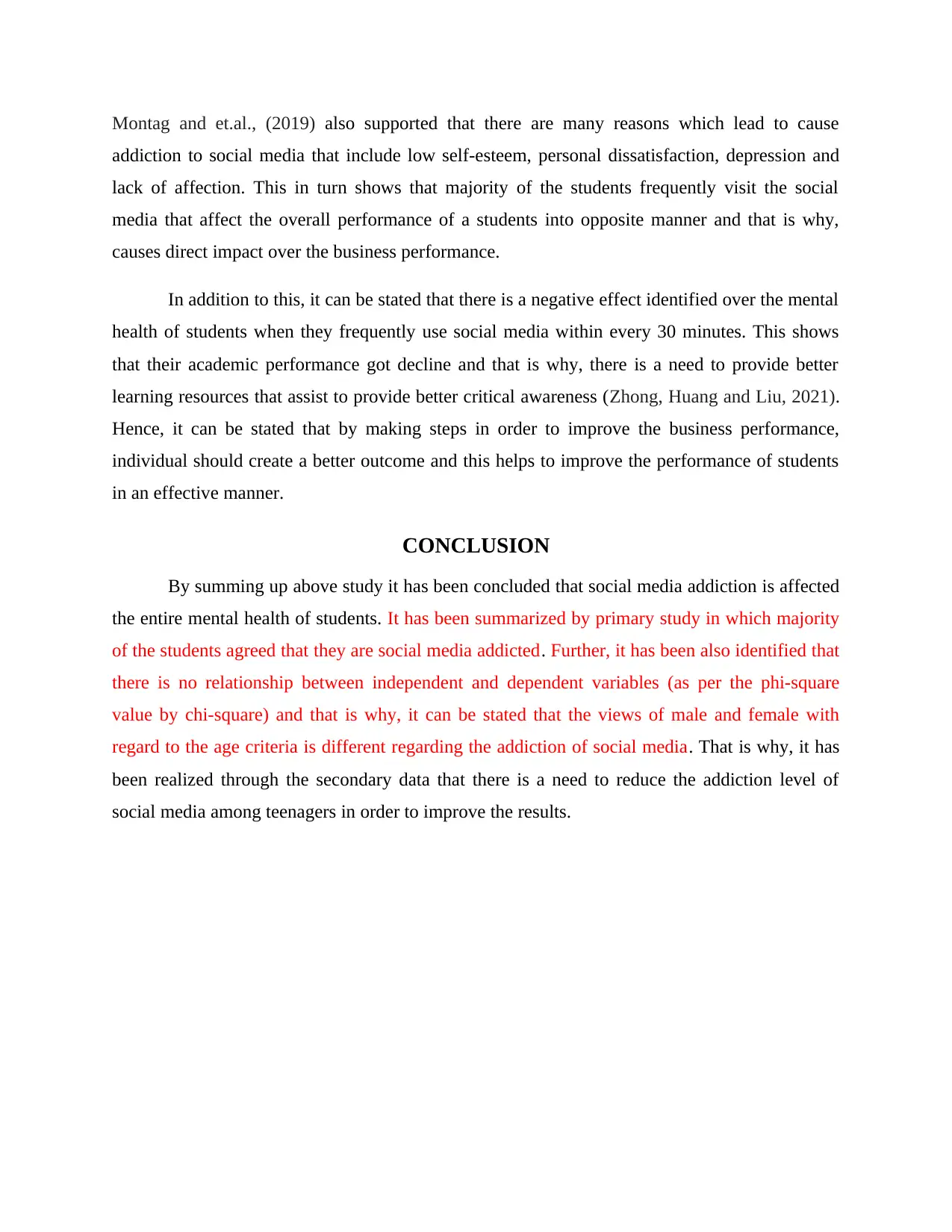
Montag and et.al., (2019) also supported that there are many reasons which lead to cause
addiction to social media that include low self-esteem, personal dissatisfaction, depression and
lack of affection. This in turn shows that majority of the students frequently visit the social
media that affect the overall performance of a students into opposite manner and that is why,
causes direct impact over the business performance.
In addition to this, it can be stated that there is a negative effect identified over the mental
health of students when they frequently use social media within every 30 minutes. This shows
that their academic performance got decline and that is why, there is a need to provide better
learning resources that assist to provide better critical awareness (Zhong, Huang and Liu, 2021).
Hence, it can be stated that by making steps in order to improve the business performance,
individual should create a better outcome and this helps to improve the performance of students
in an effective manner.
CONCLUSION
By summing up above study it has been concluded that social media addiction is affected
the entire mental health of students. It has been summarized by primary study in which majority
of the students agreed that they are social media addicted. Further, it has been also identified that
there is no relationship between independent and dependent variables (as per the phi-square
value by chi-square) and that is why, it can be stated that the views of male and female with
regard to the age criteria is different regarding the addiction of social media. That is why, it has
been realized through the secondary data that there is a need to reduce the addiction level of
social media among teenagers in order to improve the results.
addiction to social media that include low self-esteem, personal dissatisfaction, depression and
lack of affection. This in turn shows that majority of the students frequently visit the social
media that affect the overall performance of a students into opposite manner and that is why,
causes direct impact over the business performance.
In addition to this, it can be stated that there is a negative effect identified over the mental
health of students when they frequently use social media within every 30 minutes. This shows
that their academic performance got decline and that is why, there is a need to provide better
learning resources that assist to provide better critical awareness (Zhong, Huang and Liu, 2021).
Hence, it can be stated that by making steps in order to improve the business performance,
individual should create a better outcome and this helps to improve the performance of students
in an effective manner.
CONCLUSION
By summing up above study it has been concluded that social media addiction is affected
the entire mental health of students. It has been summarized by primary study in which majority
of the students agreed that they are social media addicted. Further, it has been also identified that
there is no relationship between independent and dependent variables (as per the phi-square
value by chi-square) and that is why, it can be stated that the views of male and female with
regard to the age criteria is different regarding the addiction of social media. That is why, it has
been realized through the secondary data that there is a need to reduce the addiction level of
social media among teenagers in order to improve the results.
Paraphrase This Document
Need a fresh take? Get an instant paraphrase of this document with our AI Paraphraser
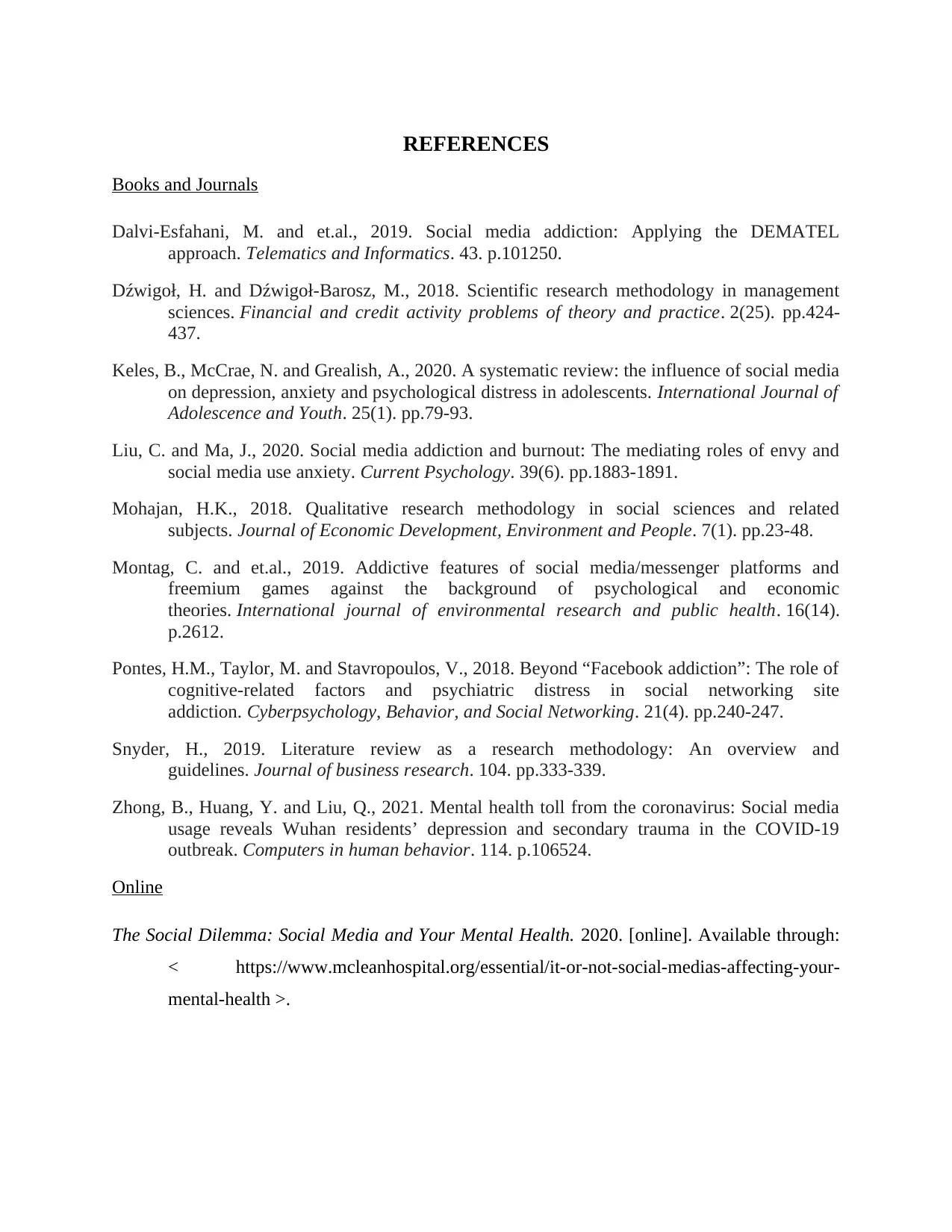
REFERENCES
Books and Journals
Dalvi-Esfahani, M. and et.al., 2019. Social media addiction: Applying the DEMATEL
approach. Telematics and Informatics. 43. p.101250.
Dźwigoł, H. and Dźwigoł-Barosz, M., 2018. Scientific research methodology in management
sciences. Financial and credit activity problems of theory and practice. 2(25). pp.424-
437.
Keles, B., McCrae, N. and Grealish, A., 2020. A systematic review: the influence of social media
on depression, anxiety and psychological distress in adolescents. International Journal of
Adolescence and Youth. 25(1). pp.79-93.
Liu, C. and Ma, J., 2020. Social media addiction and burnout: The mediating roles of envy and
social media use anxiety. Current Psychology. 39(6). pp.1883-1891.
Mohajan, H.K., 2018. Qualitative research methodology in social sciences and related
subjects. Journal of Economic Development, Environment and People. 7(1). pp.23-48.
Montag, C. and et.al., 2019. Addictive features of social media/messenger platforms and
freemium games against the background of psychological and economic
theories. International journal of environmental research and public health. 16(14).
p.2612.
Pontes, H.M., Taylor, M. and Stavropoulos, V., 2018. Beyond “Facebook addiction”: The role of
cognitive-related factors and psychiatric distress in social networking site
addiction. Cyberpsychology, Behavior, and Social Networking. 21(4). pp.240-247.
Snyder, H., 2019. Literature review as a research methodology: An overview and
guidelines. Journal of business research. 104. pp.333-339.
Zhong, B., Huang, Y. and Liu, Q., 2021. Mental health toll from the coronavirus: Social media
usage reveals Wuhan residents’ depression and secondary trauma in the COVID-19
outbreak. Computers in human behavior. 114. p.106524.
Online
The Social Dilemma: Social Media and Your Mental Health. 2020. [online]. Available through:
< https://www.mcleanhospital.org/essential/it-or-not-social-medias-affecting-your-
mental-health >.
Books and Journals
Dalvi-Esfahani, M. and et.al., 2019. Social media addiction: Applying the DEMATEL
approach. Telematics and Informatics. 43. p.101250.
Dźwigoł, H. and Dźwigoł-Barosz, M., 2018. Scientific research methodology in management
sciences. Financial and credit activity problems of theory and practice. 2(25). pp.424-
437.
Keles, B., McCrae, N. and Grealish, A., 2020. A systematic review: the influence of social media
on depression, anxiety and psychological distress in adolescents. International Journal of
Adolescence and Youth. 25(1). pp.79-93.
Liu, C. and Ma, J., 2020. Social media addiction and burnout: The mediating roles of envy and
social media use anxiety. Current Psychology. 39(6). pp.1883-1891.
Mohajan, H.K., 2018. Qualitative research methodology in social sciences and related
subjects. Journal of Economic Development, Environment and People. 7(1). pp.23-48.
Montag, C. and et.al., 2019. Addictive features of social media/messenger platforms and
freemium games against the background of psychological and economic
theories. International journal of environmental research and public health. 16(14).
p.2612.
Pontes, H.M., Taylor, M. and Stavropoulos, V., 2018. Beyond “Facebook addiction”: The role of
cognitive-related factors and psychiatric distress in social networking site
addiction. Cyberpsychology, Behavior, and Social Networking. 21(4). pp.240-247.
Snyder, H., 2019. Literature review as a research methodology: An overview and
guidelines. Journal of business research. 104. pp.333-339.
Zhong, B., Huang, Y. and Liu, Q., 2021. Mental health toll from the coronavirus: Social media
usage reveals Wuhan residents’ depression and secondary trauma in the COVID-19
outbreak. Computers in human behavior. 114. p.106524.
Online
The Social Dilemma: Social Media and Your Mental Health. 2020. [online]. Available through:
< https://www.mcleanhospital.org/essential/it-or-not-social-medias-affecting-your-
mental-health >.
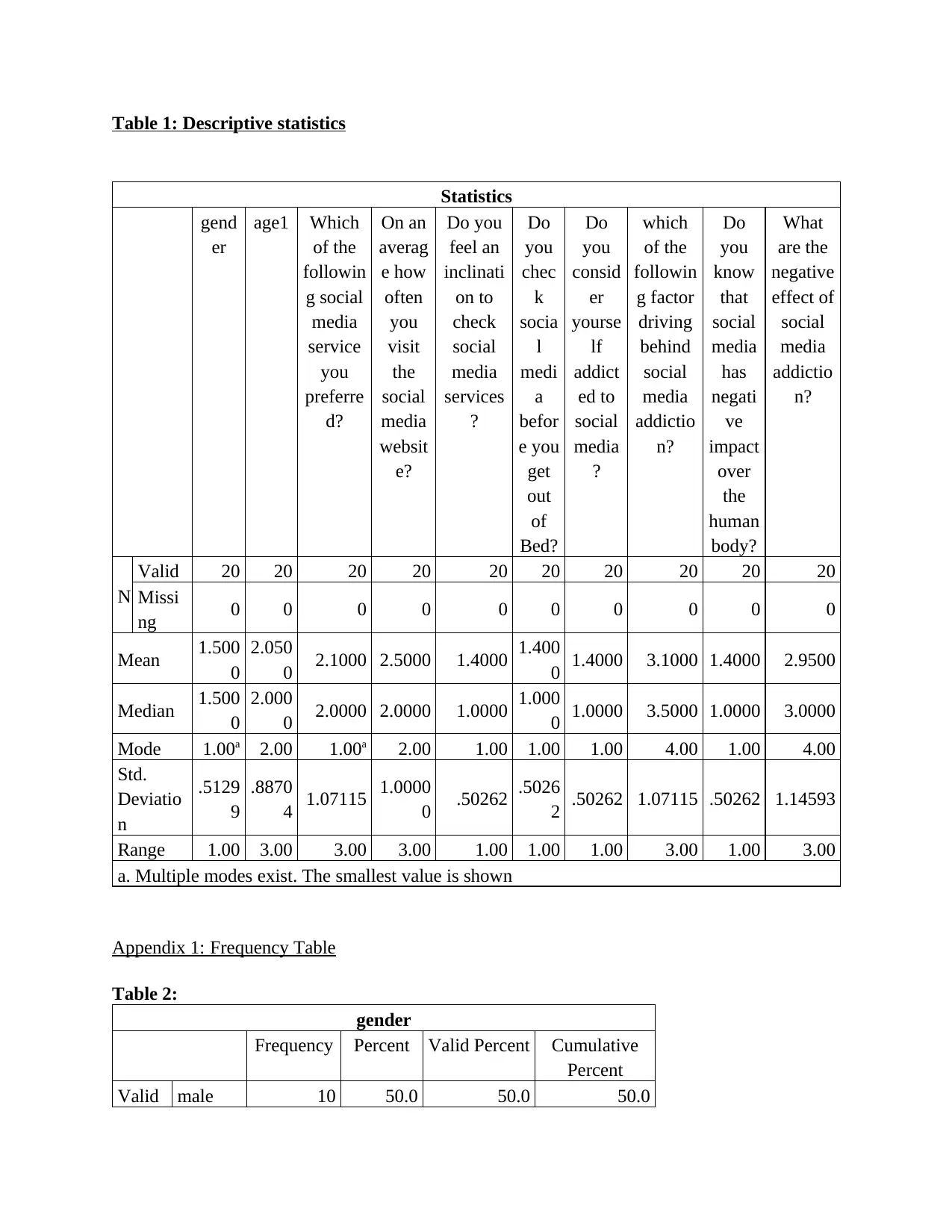
Table 1: Descriptive statistics
Statistics
gend
er
age1 Which
of the
followin
g social
media
service
you
preferre
d?
On an
averag
e how
often
you
visit
the
social
media
websit
e?
Do you
feel an
inclinati
on to
check
social
media
services
?
Do
you
chec
k
socia
l
medi
a
befor
e you
get
out
of
Bed?
Do
you
consid
er
yourse
lf
addict
ed to
social
media
?
which
of the
followin
g factor
driving
behind
social
media
addictio
n?
Do
you
know
that
social
media
has
negati
ve
impact
over
the
human
body?
What
are the
negative
effect of
social
media
addictio
n?
N
Valid 20 20 20 20 20 20 20 20 20 20
Missi
ng 0 0 0 0 0 0 0 0 0 0
Mean 1.500
0
2.050
0 2.1000 2.5000 1.4000 1.400
0 1.4000 3.1000 1.4000 2.9500
Median 1.500
0
2.000
0 2.0000 2.0000 1.0000 1.000
0 1.0000 3.5000 1.0000 3.0000
Mode 1.00a 2.00 1.00a 2.00 1.00 1.00 1.00 4.00 1.00 4.00
Std.
Deviatio
n
.5129
9
.8870
4 1.07115 1.0000
0 .50262 .5026
2 .50262 1.07115 .50262 1.14593
Range 1.00 3.00 3.00 3.00 1.00 1.00 1.00 3.00 1.00 3.00
a. Multiple modes exist. The smallest value is shown
Appendix 1: Frequency Table
Table 2:
gender
Frequency Percent Valid Percent Cumulative
Percent
Valid male 10 50.0 50.0 50.0
Statistics
gend
er
age1 Which
of the
followin
g social
media
service
you
preferre
d?
On an
averag
e how
often
you
visit
the
social
media
websit
e?
Do you
feel an
inclinati
on to
check
social
media
services
?
Do
you
chec
k
socia
l
medi
a
befor
e you
get
out
of
Bed?
Do
you
consid
er
yourse
lf
addict
ed to
social
media
?
which
of the
followin
g factor
driving
behind
social
media
addictio
n?
Do
you
know
that
social
media
has
negati
ve
impact
over
the
human
body?
What
are the
negative
effect of
social
media
addictio
n?
N
Valid 20 20 20 20 20 20 20 20 20 20
Missi
ng 0 0 0 0 0 0 0 0 0 0
Mean 1.500
0
2.050
0 2.1000 2.5000 1.4000 1.400
0 1.4000 3.1000 1.4000 2.9500
Median 1.500
0
2.000
0 2.0000 2.0000 1.0000 1.000
0 1.0000 3.5000 1.0000 3.0000
Mode 1.00a 2.00 1.00a 2.00 1.00 1.00 1.00 4.00 1.00 4.00
Std.
Deviatio
n
.5129
9
.8870
4 1.07115 1.0000
0 .50262 .5026
2 .50262 1.07115 .50262 1.14593
Range 1.00 3.00 3.00 3.00 1.00 1.00 1.00 3.00 1.00 3.00
a. Multiple modes exist. The smallest value is shown
Appendix 1: Frequency Table
Table 2:
gender
Frequency Percent Valid Percent Cumulative
Percent
Valid male 10 50.0 50.0 50.0
⊘ This is a preview!⊘
Do you want full access?
Subscribe today to unlock all pages.

Trusted by 1+ million students worldwide
1 out of 36
Related Documents
Your All-in-One AI-Powered Toolkit for Academic Success.
+13062052269
info@desklib.com
Available 24*7 on WhatsApp / Email
![[object Object]](/_next/static/media/star-bottom.7253800d.svg)
Unlock your academic potential
Copyright © 2020–2025 A2Z Services. All Rights Reserved. Developed and managed by ZUCOL.




